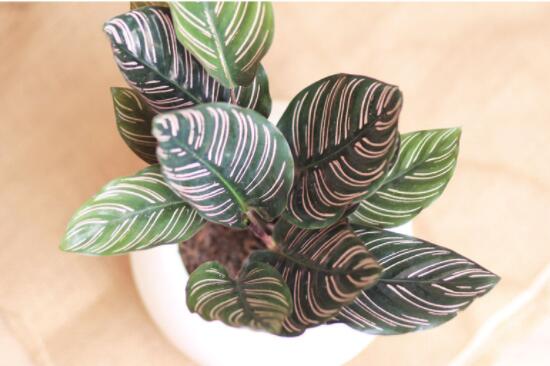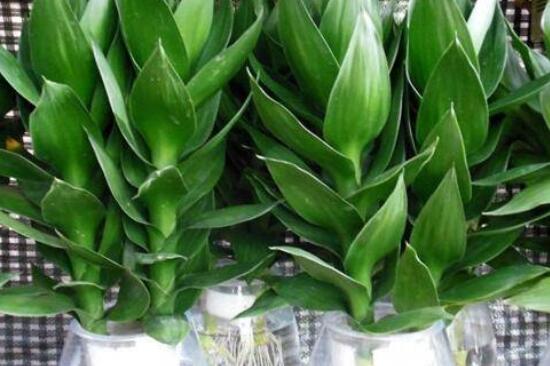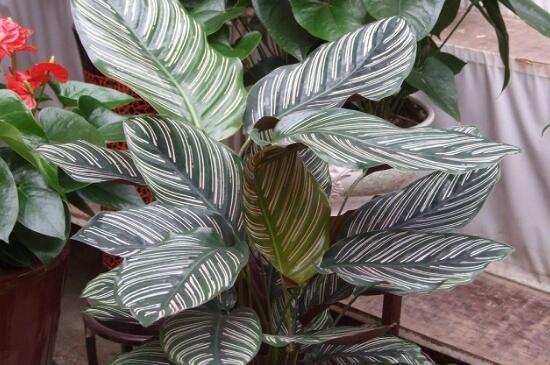How to raise double-line taro, culture methods and matters needing attention / avoid strong light
Double-line taro, an evergreen herbaceous foliage plant with charming leaf color, is very suitable for indoor breeding and has the effect of decoration and beautification. In life, after knowing the efficacy of double-line taro, many people want to raise it, so how to raise it? The following are the breeding methods and matters needing attention of double-line taro, very comprehensive, friends who want to raise come in and have a look!
First, how to raise double-line taro and understand the habits

Double-line taro likes a warm, humid environment, it likes light, shade-resistant, not cold-resistant, not resistant to drought, but also avoid exposure, so how to raise double-line taro? We should put it in a place with sufficient astigmatism, water frequently to keep the basin soil moist, and take measures to keep warm in winter. As for the cultivated soil, it is better to be a slightly acidic soil with loose and fertile soil and good drainage and air permeability.
2. Culture methods and matters needing attention of double-line taro
1. Basin soil
How to raise potted double-line taro, first of all, the pot soil should be changed. Because the double-line taro potted plants purchased by the florist or online have existing potted soil, but the soil is generally very cheap and can ensure the normal growth of the plant, but if you want to raise it well, it is best to re-cultivate the soil.
Soil selection: according to the growth habits of double-line taro, it likes loose and fertile soil, good drainage and air permeability, and slightly acidic soil rich in humus. In this regard, the editor recommends that we use a mixture of pond mud, peat and perlite at the ratio of 2:3:1.
2. Lighting
In the cultivation methods and matters needing attention of double-line taro, light is extremely key. Although it likes light, it grows more in a semi-shady environment. It is said that it will be fine for 4-6 weeks in a dark room. Therefore, when breeding indoors, we should put the double-line taro in a place where the light is bright and the bright light can be avoided.
Note: double-line taro avoid strong light, in the strong light, especially in summer, must be shaded, otherwise it is very easy to cause leaf burns, resulting in double-line taro leaves yellowing, affecting its ornamental value.
3. Temperature
Bamboo taro likes warmth, is not cold-resistant, and is afraid of high temperature, so how to raise it and adjust the temperature is also very important. It is understood that the most suitable growth temperature of double-line taro is 20-30 ℃. When we breed indoors, it is best to maintain this temperature, so that taro will grow very well.
Note: in summer, when the temperature is higher than 35 ℃, you should put it in a cool place for cooling; in winter, when the room temperature is lower than 10 ℃, you can move the plant to a windless, warmer room to survive the winter.
4. Watering
Water is the source of life, so watering is an indispensable part of the culture method of double-line taro. Double-line taro likes the humid environment and has higher requirements for water. It is watered once a day in spring and autumn, 3-4 times a day in summer and every 2-3 days in winter.
Note: double-line taro is not resistant to drought, once underwatered, the plant leaves will wilt, and then can not recover; at the same time, not too much watering, otherwise the soil is too sticky, too wet, the plant is very easy to rot roots and cause disease.
5. Fertilization
How to raise double-line taro? After talking about watering, let's talk about fertilization, it is also an extremely critical link. In the peak growing season of double-line taro, we should apply it every two weeks, and the fertilizer can be mixed with peanut bran and compound fertilizer or mature compost.
Note: taro is very sensitive to high concentration of fertilizer, so do not apply too much fertilizer, otherwise it is easy to burn leaves. Therefore, when applying fertilizer to double-line taro, we should follow the principle of "frequent application and thin application".
6. Diseases and insect pests
In the growth process of double-line taro, due to improper maintenance and other reasons, the plant will inevitably get sick. Among them, the insect pests are mainly shell insects and red spiders, and the diseases are mainly white silk disease and leaf spot. Once the occurrence of diseases and insect pests, we should spray medicine for prevention and control, as for what medicine to spray, you can refer to double-line taro pest control.
Generally speaking, double-line taro is quite easy to raise, but if you want to make it look good, we need to pay more attention and maintain it in accordance with the requirements, so that the leaves of double-line taro can be beautiful and attractive. With regard to the culture methods and matters needing attention of bamboo taro, this is the end of the editor's introduction. Passionate flower friends might as well raise and see.
How to raise double-line taro culture methods and matters needing attention
Double-line taro is a kind of ornamental plant whose leaves are relatively large and evergreen. There will be some white lines on the leaves, which is very special. Double-line taro is a kind of plant which is very suitable for domestic cultivation and has the function of purifying air. So how to breed it in order to make it grow well?
How to raise double-line taro
1. The suitable growth temperature of double-line taro is 20-30 ℃, the best growth temperature is 18-21 ℃ in daytime, 16-18 ℃ at night, and the safe overwintering temperature is 10 ℃. Therefore, in summer to prevent high temperature exposure, put it in a cool place; winter should pay attention to cold, plants can be moved to a windless, warmer indoor winter.
2. Double-line taro avoid direct sunlight and grow better under indirect radiation or scattered light. Especially in summer, direct sunlight can easily cause leaf burns, so the production is cultivated under the artificial control of light with a shading net with a refractive index of 75% and 80%. If leaf burns are found, immediately move them to places without direct light or shaded facilities or in the shade of trees, and cut off the burnt leaves to prevent other pathogenic bacteria from invading from the wound. At the same time, strengthen the management of water and fertilizer.
Culture method of double-line Taro
1. Temperature. Double-line taro likes warm environment, the suitable growth temperature is 20 ℃-30 ℃, the best growth temperature is 18 ℃-21 ℃ in daytime, 16 ℃-18 ℃ at night, and more than 10 ℃ can survive the winter safely. So in summer to prevent high-temperature exposure, and put the double-line taro in a cool place, pay attention to the cold in winter, transfer the plant indoors.
2. Watering. The peak growth period of double-line taro is from March to October, and the air humidity should be maintained at 75% 85%. The high air humidity is beneficial to the development of leaves, so they should be watered more during the growing period and often sprayed to the leaves. The appropriate watering method is to spray the leaves in the morning, water the basin soil in the afternoon, and irrigate the whole plant in the evening.
3. Light. Double-line taro is not resistant to direct sunlight, so we should do a good job of shading in summer. Let the double-line taro absorb the scattered light.
4. Soil. Double-line taro prefers fertile and loose soil to soil consolidation and stagnant water. Fertile humus soil and porous coarse media are generally used as substrates.
5. Fertilization. The fertilization of double-line taro should follow the principle of "a small amount and many times", and the mixed fertilizer of peanut bran and compound fertilizer or mature compost should be applied every 2 weeks in the peak growing season.
Matters needing attention of double-line taro
1. The sun is strong in summer, and the leaves of double-line taro are easy to burn in direct sunlight, so put the plant in a place where there is no direct light. if you find that the leaves are burned, you should cut off the leaves immediately to avoid the invasion of pathogens.
2. Stop fertilization during dormant period in winter and hot period in summer. The concentration of fertilizer should not be too high, otherwise it will cause leaf burns and in severe cases the plant will die.
Common diseases of double-line taro and their control methods
1. White silk disease. Prevention and control method: 0.2% of the soil weight of 70% pentachloronitrobenzene can be added to the basin soil to sterilize the soil. When the sclerotia is not formed, the diseased plants are uprooted, the soil is discarded and the new soil is used. In daily maintenance, we should always pay attention to ventilation, planting is not too dense.
2. Leaf spot. Prevention and control methods: increase the application of base fertilizer to ensure the fertility of the soil and enhance disease resistance. It is found that the diseased leaves are removed in time to prevent and control the further spread of germs. if the disease is more serious, it should be disposed of in time. Before the onset of the disease, you can spray 75% chlorothalonil wettable powder 500,600 times liquid or spray 75% chlorothalonil wettable powder 1000 times liquid plus 70% methyl thiobacillus wettable powder 1000 times liquid for prevention and treatment.
The culture method of double-line taro can start with its growth habits, and it must do a good job of temperature and light when breeding, it can not accept the direct light for a long time, so it is best to do shading treatment in summer. The disease prevention and control of double-line taro is also very important and must be done in place.
What if the leaves of double-line bamboo taro turn yellow, suitable for light / reasonable water and fertilizer / spraying for diseases and insect pests
As a common foliage plant, the leaves of double-line taro are rich in color, which are equal to white, green and red, giving people a unique visual enjoyment. But in the process of breeding, because of some reasons, its leaves will be yellow, thus affecting the overall ornamental, then double-line taro leaves yellow how to do? Today, the editor is here to solve this problem for everyone.
First, what if the leaves of the double-line taro turn yellow?
When it comes to the yellowing of double-line taro leaves, in addition to environmental discomfort, it is caused by improper maintenance: when the light is insufficient or too strong, add light or shade; water and fertilizer is inappropriate, reasonable watering and fertilization, if there are rotten roots, you should also take off the pot and cut the roots, and then change the pot soil to plant again; if it is caused by diseases and insect pests, spray in time for prevention and control.
Second, the causes and remedial measures of yellowing of double-line taro leaves.
1. Environmental mutation
As for the reason for the yellowing of double-line taro leaves, if it is a new potted plant, it may be caused by a sudden change in the environment. Because many of the flower friends' double-line taro potted plants are purchased online, it is easy to cause a big change in the environment, and the double-line taro can not adapt for a while, resulting in leaf yellow symptoms.
Remedy: according to the growth habits of double-line taro, we should create an optimal growth environment for the newly bought potted plants. after a period of time, the plant will return to health.
2. Improper lighting
Lack of light: although double-line taro is shady, it also has a demand for light. once it is in a shady environment for a long time, its leaves will turn yellow because they do not get enough sunlight to form chlorophyll. Remedy: supplement the light, but be careful that the light is not too strong.
The light is too strong: double-line taro avoid strong light, once the strong sun shines directly on its leaves, it is easy to cause flower leaf tip, leaf edge withered, leaf sunrise part of the macula. Remedy: move the flowerpot to the shade in time, wait for it to slow down, then water it properly, and then gradually move to a place with good light.
3. Improper watering
Too little watering: double-line taro likes the humid environment, daily maintenance needs frequent watering to keep the basin soil moist. Once the water is underwatered, the leaves will turn yellow because of lack of water, which shows that the old leaves wither and fall off from the bottom up, but the new leaves grow normally. Remedy: appropriate amount of watering, sufficient watering and thorough watering.
Overwatering: double-line taro likes water, but there is also a degree if it is watered too much, resulting in stagnant water in the basin, the root system will have difficulty breathing, resulting in symptoms of yellowing of double-line taro leaves. Remedy: put the double-line taro in a ventilated and cool place, let the moisture evaporate quickly, and those with rotten roots need to be cut off, and then put back into the basin.
4. Excessive fertilization
Insufficient fertilization: the leaves of double-line taro are broad and rich in color. If you want it to grow well, it is very important to apply the right amount of fertilizer. In the process of breeding, if there is not enough fertilizer, the old leaves will turn yellow because of lack of nutrients. Remedy: replenish nutrients in time, but to double-line taro fertilizer should adhere to thin fertilizer diligently.
Excessive fertilization: although double-line taro likes fertilizer, too much fertilizer will produce fertilizer damage, resulting in dry brown at the tip of the new leaves, and concave and convex not stretched, and the old leaves are scorched yellow and fall off. Remedy: immediately stop fertilizing, and then diluted with water; if the roots are burned, people should also take off the plant, cut off the rotten roots, and then replace them with new potted soil and replant them.
5. Diseases and insect pests
Except for the above points, the yellowing of double-line taro leaves may be caused by diseases and insect pests. It is understood that in the case of improper maintenance and poor environment, double-line taro may be attacked by aphids and shell insects, which mainly harm the leaves of the plant, resulting in yellow leaves.
Remedy: it is simple to identify specific pests and then control them by spraying. As for what kind of medicine should be sprayed, you can refer to the pest control of double-line taro.
Generally speaking, the culture method of double-line taro is not difficult, but because many flower friends are novice, it is inevitable to have the symptom of leaf yellow. However, after reading the full text, I believe you have a bottom in your mind, and the Ye Huang problem can be remedied in accordance with the above methods. With regard to the yellowing of double-line taro leaves, the editor has introduced this, hoping to give you some help.
- Prev

How to propagate lotus bamboo, two propagation methods of lotus bamboo (cutting / sowing)
As a common indoor potted plant, lotus bamboo plays a lot of roles. It can not only be used for viewing, but also beautify the home and purify the air. For such plants, it is good to raise one pot, and more pots are better. If you don't want to waste money, it is necessary to master the breeding method of lotus bamboo. So, how does lotus bamboo reproduce?
- Next

What to do if the leaves of double-line taro are rolled up, proper shading / reasonable watering / disease spraying
For double-line taro, flower friends who have seen it should be impressed. It is a beautiful foliage plant. Although it is not as characteristic as peacock taro, its white, green and red leaves also look extremely beautiful. So when the leaves of bamboo taro curl, flower friends must be in a hurry! that
Related
- Fuxing push coffee new agricultural production and marketing class: lack of small-scale processing plants
- Jujube rice field leisure farm deep ploughing Yilan for five years to create a space for organic food and play
- Nongyu Farm-A trial of organic papaya for brave women with advanced technology
- Four points for attention in the prevention and control of diseases and insect pests of edible fungi
- How to add nutrient solution to Edible Fungi
- Is there any good way to control edible fungus mites?
- Open Inoculation Technology of Edible Fungi
- Is there any clever way to use fertilizer for edible fungus in winter?
- What agents are used to kill the pathogens of edible fungi in the mushroom shed?
- Rapid drying of Edible Fungi

